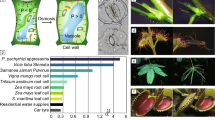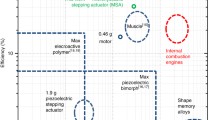Abstract
This paper presents the design and analysis of an osmosis-based artificial muscle inspired by the leaf movements of Mimosa pudica. M. pudica’s leaves quickly contract using osmosis pressure in the pulvinus when they are stimulated. We analyzed and simulated an osmosis system to identify the factors for fast osmosis reactions and designed a prototype artificial muscle based on the results. The osmosis phenomenon was mathematically modeled, analyzed, and verified through several experiments. The analysis shows that fast osmosis responses require a large diffusion coefficient with a high-flux membrane or small ratio of the cross-sectional area to the volume of the osmosis system. We designed a micro-scale system to achieve the required ratio. The contraction and relaxation of the artificial muscle are realized by changes of the local concentration of potassium ions, which can be aggregated by a controllable electric field. As a result, the artificial muscle shows controllable behavior with fast reactions.
Similar content being viewed by others
References
Ariano P, Accardo D, Lombardi M, Bocchini S, Draghi L, De Nardo L, Fino P. Polymeric materials as artificial muscles: An overview. Journal of Applied Biomaterials & Functional Materials, 2015, 13, 1–9.
Madden J D W, Vandesteeg N A, Anquetil P A, Madden P G A, Takshi A, Pytel R Z, Lafontaine S R, Wieringa P A, Hunter I W. Artificial muscle technology: Physical principles and naval prospects. IEEE Journal of Oceanic Engineering, 2004, 29, 706–728.
Noritsugu T, Tanaka T. Application of rubber artificial muscle manipulator as a rehabilitation robot. IEEE/ASME Transactions on Mechatronics, 1997, 2, 259–267.
Chuc N H, Vuong N H L, Kim D, Moon H, Koo J C, Lee Y, Nam J D, Choi H R. Design and control of a multi-jointed robot finger driven by an artificial muscle actuator. Advanced Robotics, 2010, 24, 1983–2003.
Pelrine R, Kornbluh R D, Pei Q B, Stanford S, Oh S, Eckerle J, Full R J, Rosenthal M A, Meijer K. Dielectric elastomer artificial muscle actuators: Toward biomimetic motion. Smart Structures and Materials 2002: Electroactive Polymer Actuators and Devices (EAPAD), 2002, 4695, 126–137.
Krishna S, Nagarajan T, Rani A M A. Review of current development of pneumatic artificial muscle. Journal of Applied Sciences, 2011, 11, 1749–1755.
Hirano L A, Escote M T, Martins-Filho L S, Mantovani G L, Scuracchio C H. Development of artificial muscles based on electroactive ionomeric polymer-metal composites. Artificial Organs, 2011, 35, 478–483.
Malchesky P S. Artificial organs 2011: A year in review. Artificial Organs, 2012, 36, 291–323.
Chen D, Pei Q B. Electronic muscles and skins: A review of soft sensors and actuators. Chemical Reviews, 2017, 117, 11239–11268.
Romasanta L J, Lopez-Manchado M A, Verdejo R. Increasing the performance of dielectric elastomer actuators: A review from the materials perspective. Progress in Polymer Science, 2015, 51, 188–211.
Barcohen Y. EAP as artificial muscles-Progress and challenges. Proceedings of the Society of Photo-Optical Instrumentation Engineers (SPIE), San Diego, CA, USA, 2004, 5385, 10–16.
Song S H, Lee H, Lee J G, Lee J Y, Cho M H, Ahn S H. Design and analysis of a smart soft composite structure for various modes of actuation. Composites Part B: Engineering, 2016, 95, 155–165.
Kim M C, Shin Y J, Lee J Y, Chu W S, Ahn S H. Pulse width modulation as energy-saving strategy of shape memory alloy based smart soft composite actuator. International Journal of Precision Engineering and Manufacturing, 2017, 18, 895–901.
Hall J E G, Arthur C. Textbook of Medical Physiology, Elsevier Saunders, St. Louis, Mo, USA, 2006, 72–99.
Kwan K W, Ye Z W, Chye M L, Ngan A H W. A mathematical model on water redistribution mechanism of the seismonastic movement of Mimosa Pudica. Biophysical Journal, 2013, 105, 266–275.
Eisner T. Leaf folding in a sensitive plant: A defensive thorn-exposure mechanism? Proceedings of the National Academy of Sciences of the United States of America, 1981, 78, 402–404.
Weintraub M. Leaf movements in Mimosa Pudica L. New Phytologist, 1952, 50, 357–382.
Volkov A G, O'Neal L, Volkova M I, Markin V S. Morphing structures and signal transduction in Mimosa Pudica L. induced by localized thermal stress. Journal of Plant Physiology, 2013, 170, 1317–1327.
Maex R. On the Nernst-Planck equation. Journal of Integrative Neuroscience, 2017, 16, 73–91.
Oster G, Peskin C S. Dynamics of osmotic fluid flow. In: Karalis, Theodoros K, ed., Mechanics of Swelling, Springer Berlin Heidelberg, Berlin, Germany, 1992, 731–742.
Massaldi H A, Borzi C H. Non-ideal phenomena in osmotic flow through selective membranes. Journal of Membrane Science, 1982, 12, 87–99.
Wang X Y, Cheng C, Wang S L, Liu S R. Electroosmotic pumps and their applications in microfluidic systems. Microfluidics and Nanofluidics, 2009, 6, 145–162.
Wijesinghe R S, Roth B J. Lorentz effect imaging of ionic currents in solution using correct values for ion mobility. Journal of Magnetic Resonance, 2010, 204, 225–227.
Allen R D. Mechanism of the seismonastic reaction in Mimosa pudica. Plant Physiology, 1969, 44, 1101–1107.
Balmer R T, Franks J G. Contractile characteristics of Mimosa pudica L. Plant Physiology, 1975, 56, 464–467.
Pal S. Design of Artificial Human Joints & Organs, Springer, Boston, MA, USA, 2014, 23–40.
Author information
Authors and Affiliations
Corresponding author
Rights and permissions
About this article
Cite this article
Gim, J., Ahn, C. Design and Analysis of Osmosis-based Artificial Muscle. J Bionic Eng 16, 56–65 (2019). https://doi.org/10.1007/s42235-019-0006-7
Published:
Issue Date:
DOI: https://doi.org/10.1007/s42235-019-0006-7




